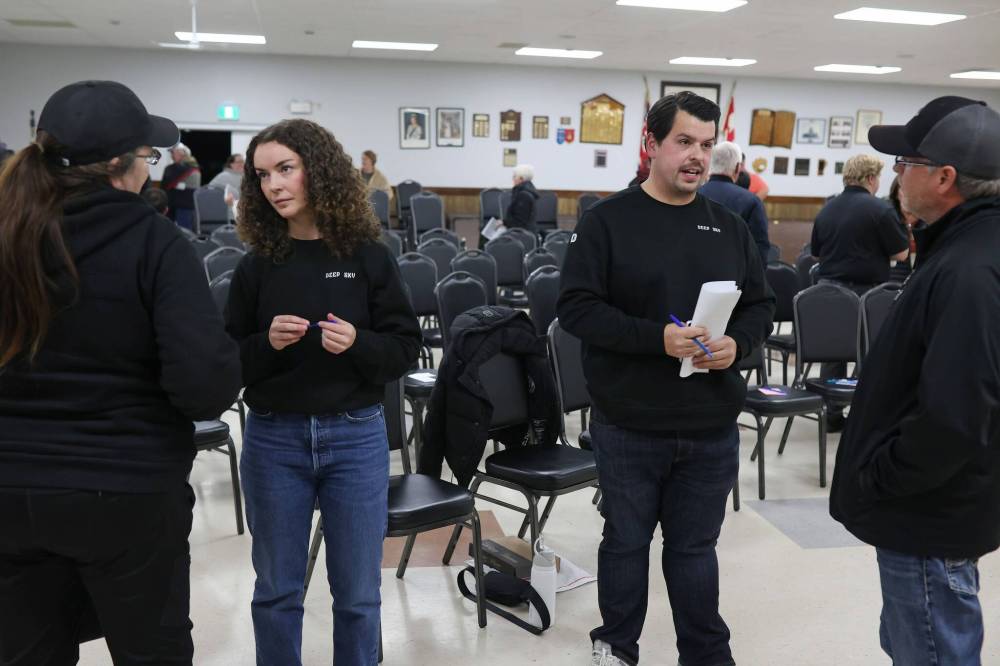PIPESTONE — Residents were left with many unanswered questions after a community-sponsored meeting in Pipestone Wednesday night about a proposed carbon capture facility for the area.
Montreal-based Deep Sky plans to build one of the world's largest facilities in western Manitoba at a cost of about $200 million. The Rural Municipality of Pipestone and the Municipality of Two Borders were identified by the company as “promising” locations for the 100-employee business.
The event included an informational video about carbon capture and prepared responses from Deep Sky, which were read aloud by the organizer.
Jim Anderson of Melita asks a question during a community town hall Wednesday night to discuss concerns about the Deep Sky carbon capture facility planned for the area. (Tim Smith/Brandon Sun)
About 250 people gathered for the meeting at the Pipestone Community Hall.
“Our communities do not have the infrastructure to support the proposed massive influx of people that Deep Sky promises,” said event host Keeley Woods.
Woods asked city officials (none of whom were present) how the council knew about the project and why they didn't tell the community about it sooner.
“People who live in rural communities do it because of the lifestyle it brings,” Woods said. “We love the slower pace of life, connection to nature, more space, affordable housing, lower cost of living, a sense of security, a sense of belonging to a close-knit community that leads to strong relationships with neighbors who help each other.”
The proposed facility will be able to store up to 500,000 tonnes of CO2 per year after completion of Phase 3 and 30,000 tonnes of CO2 in the first year. The company's only other facility in Alberta has an annual capacity of 3,000 tonnes.
James Wilt, policy manager for the Climate Action Team, a coalition of environmental organizations in Manitoba, listed some of the main concerns with the proposal.
He said there were currently no examples of large-scale direct air capture plants in the world, that similar smaller plants faced problems once they were built, that they were expensive and depended on companies buying CO2 offsets.
The startup makes money by selling credits to companies that create emissions and want to become carbon neutral by offsetting the emissions they create.
Sean Day, Deep Sky's director of project development and community partnerships, told the Sun the company is still waiting on a feasibility study from Manitoba Hydro before announcing its final location, but reiterated that the two municipalities are the preferred options.
He declined to answer questions about the project's impact on the region's water supply and hydropower use, saying the company was still working on the “technical details.”
He said those answers would come in the future.
Wilt said the current installation depends on the successful development of future technologies.

Pipestone's Keely Woods of the informal Facebook group Grounded in Truth – Deep Sky Awareness (southwest Manitoba) talks with other communities and area residents after Wednesday's meeting. (Tim Smith/Brandon Sun)
“The claim is that technological innovation, which has not yet happened, will reduce electricity demand,” Wilt said. “So all of this is essentially presented as innovation that we just have to count on.”
Resident Kim McKenzie said she was concerned about how Deep Sky's construction in the area could “impact everything from the environment to our way of life.”
“We don't have the infrastructure to handle the expected influx of people,” she said.
June Greggor, a Reston resident, said even after attending the presentation, she doesn't feel like she knows what's going on.
“I hope more (information) comes out, and I will definitely be at the next meeting,” Greggor said after the presentation ended.
Kelvin Siemens, who lives in the nearby rural municipality of Wallace-Woodworth, said after listening to the meeting that he wasn't sure carbon capture was ready to be implemented on a large scale.
“At this stage it seems terribly inefficient and ineffective,” he said.
He said the lack of local government representation from Two Borders or Pipestone was “extremely disappointing.”
“If you're an elected official, you have to have the gonads to support what you think is right,” Siemens said.
At this point, he said he's not sure if he would support building Deep Sky in the region, but given the information he has, “why would you build this monster?”
Kelly Taylor, who lives near Reston, said she was “quite disappointed” that no one from local government showed up, but said the meeting was informative.

Kelsey Pedersen, Deep Sky project manager, and Sean Day, the company's director of project development and community partnerships, speak with area residents during the event. (Tim Smith/Brandon Sun)
“I'm open to anything that, you know, will lead to job creation and positivity, but we still don't know enough about it,” she said.
During the question-and-answer session, residents asked how their tax dollars would be used and how the company would financially build the world's largest carbon capture facility.
Two Deep Sky representatives present at the meeting did not formally address the crowd but said the company is not seeking municipal, provincial or federal funding.
They advised residents to email with questions.
The company hopes to begin construction in the third quarter of 2026, pending provincial regulatory approval. The goal is to have the entire facility open no later than 2031 so that the business can benefit from federal tax credits.
The Manitoba plant will use technology similar to large fans that will suck air from the atmosphere, and use sorbent technology—like sponges—that will separate CO2 from the air. It will then turn the CO2 into liquid and release it two kilometers into salty aquifers.
The organizers collected questions from those present and promised to forward them to Deep Sky.








